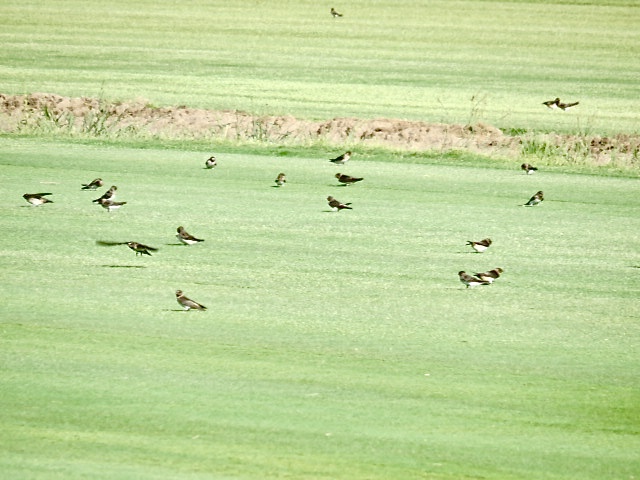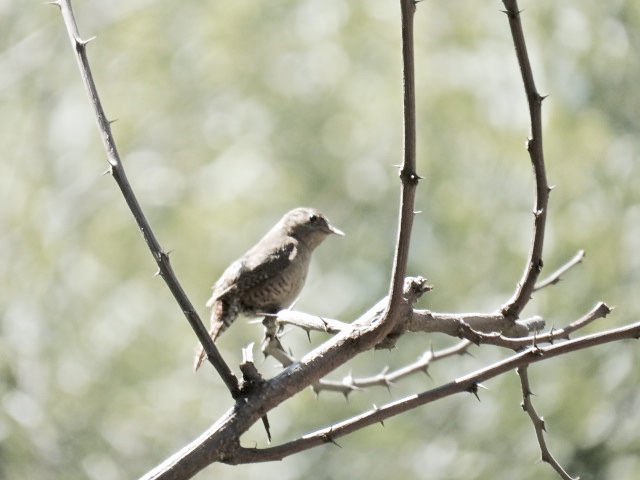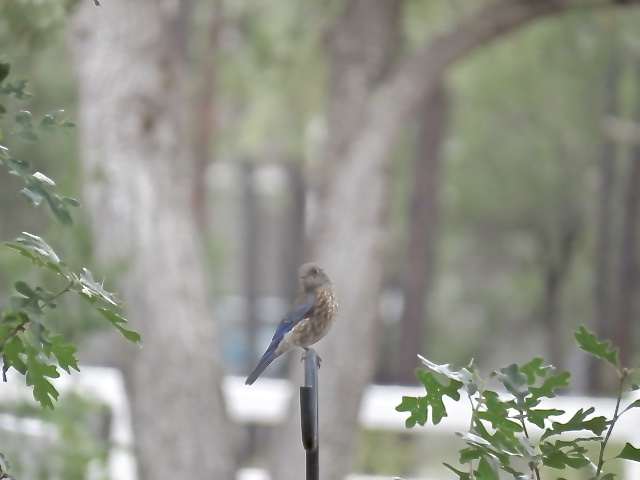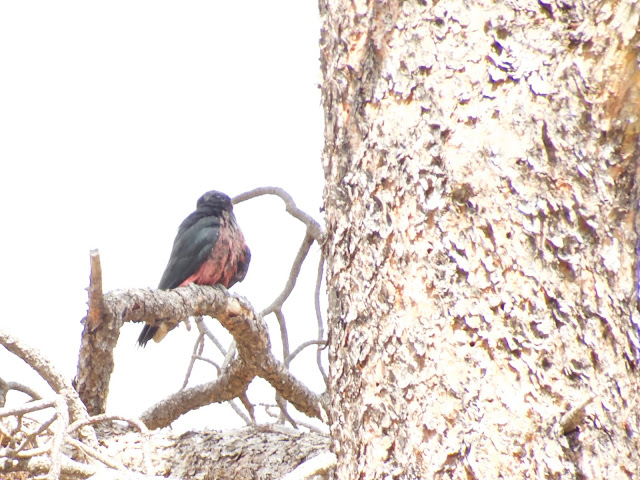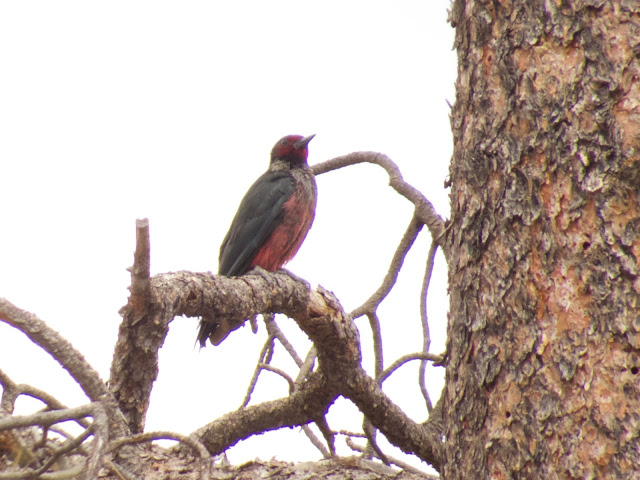Thursday/Friday July 27 & 28, 2017
Driving 180 miles to see some sparrows? Yes, but these weren’t just ordinary sparrows, they were “monsoon” sparrows that come to southern Arizona to breed during the summer months. Need to go when the males of one species arrive and begin to sing or do their flight displays…a miniature version of a Eurasian Skylark.
Sue Moreland joined in for the fun. With an early start from Phoenix, we started listening for sparrows at 7:30 a.m. in the Las Cienegas National Conservation Area near Sonoita, off of SR 83.
Under cloud cover, we stopped within 100 yards of the entrance to listen to BOTTERI’S SPARROW singing on the north side of the road. Since we were barely into the grasslands, I drove a bit farther before stopping but this was way prior to the signage for the area. One was at the top of a mesquite singing; we both knew its song that wraps up with a bouncing-ball trill.
 |
| BOTTERI'S SPARROW, slight rufous on top of wing, larger grayer bill than Cassin's Sparrow |
There’s another sparrow that arrives with the monsoon, but it was quiet. In the deep grass across from the Botteri’s Sparrows, small birds apparently were foraging and running like mice through the grass, too thick to find. We knew what they might be…but didn’t want to go tromping through their territory, so moved on with the car.
CASSIN’S KINGBIRDS were perched in the mesquites, flying out to grab insects (some big like dragonflies) and returning to its perch to eat.
Several EASTERN MEADOWLARKS (Lilian’s subspecies) were singing from perches on shrubs or the scrubby mesquites.
Two LOGGERHEAD SHRIKES were hunting from an overhead utility line. I haven’t seen many of them this year, so that felt like a very good sighting, too.
Seldom can we enjoy a lot of bird activity without a hawk showing up. Sue spotted the SHARP-SHINNED HAWK. I caught its gray under color (making it a juvenile).
Before reaching the turnoff for the Empire Ranch property, we began to hear the CASSIN’S SPARROWS singing on the south side of the dirt road. For some reason, I really like this bird. Maybe it’s the song that enables me to ID it. It starts out with some clear whistles, then brief ‘song’ that ends with two low notes. If it sings without including those two low notes, I’d never recognize it, since I see it only about once a year. To me, those two low notes = “10/4” = or “over and out” or “the end”.
Fortunately, it was singing that song from the top of a short shrub, then flying up into the air about six feet, before fluttering down to land on another shrub about ten feet from where it started. Others, farther out in the grasslands were doing likewise, so we heard more and more male CASSIN’S SPARROWs beginning their flight displays.
Rapt with enjoyment, we watched for quite some time. Photos can’t capture the feelings of the moment and, in this case, I did a poor job of even photographing the small birds,that were quite distant, hidden in shrubs, perched briefly in the open, or up in the air with their flight display.
 |
| CASSIN'S SPARROW, shorter pointy bill (than Botteri's), faint eye ring |
Since we planned to drive all the way through Las Cienegas to exit at the South entrance, we didn’t take time to visit Empire Ranch. The action, for me, was in the grasslands and I wanted to spend as much time out there as possible. An hour and a half had already disppeared!
Sue was finding birds, too. After turning away from the north entrance and heading south, she spotted LARK SPARROWs in the road that flew to nearby shrubs.
The turn-off to see the Black-tailed Prairie Dogs (released into this area) was quite muddy, so we continued on the main road that was passable in my little sedan. But we stopped long enough to get our binoculars on the site where Sue counted nine (9) of them up and out in the open.
A SWAINSON’S HAWK flew overhead. Again, that’s not a common bird in the east Phoenix area, so I’m always excited to see them.
 |
| SWAINSON'S HAWK (from my file; sky very dark with clouds today) |
There were more BOTTERI’S and CASSIN’S SPARROWs singing away.
And now! We heard numerous GRASSHOPPER SPARROWs. My identification problem with them is how do you know if an insect is calling from within the tall grasses? Or, whether it’s the sparrow.
It helps when that flat-headed bird finds a low branch to sing its very buzzy song.
 |
| GRASSHOPPER SPARROW |
At the very full ponds (tank), we spotted a GREAT EGRET, SUMMER TANAGER, male and female VERMILION FLYCATCHER, and a BROWN-CRESTED FLYCATCHER.
 |
| GREAT EGRET |
 |
| VERMILION FLYCATCHER |
 |
| Sue, leading on the trail into Sacaton Flats with its special grass |
After spending four hours at the beautiful grasslands of Las Cienegas, we reached the South Entrance and exited onto SR 82. Our stomachs knew it was going on lunch time. So, when we arrived at San Pedro House in Sierra Vista, we took immediate advantage of their picnic ramada to eat lunch while enjoying BLUE GROSBEAK, PYRRHULOXIA, and the calls of WHITE-WINGED and INCA DOVEs.
On our brief walk to the San Pedro River, we spotted a couple flycatchers (ASH-THROATED & BROWN CRESTED) along with a flock of BARN SWALLOWs. But our visit was cut short by lightening and thunder. We had seen the storm cloud dropping lots of rain south of us (Bisbee?) and it was quickly moving its water-laden darkness our way.
Our next planned stop at Ash Canyon B&B appeared to be relatively storm-cloud free, although the city itself was under cloud cover. So, we wrapped up our afternoon there (2 hours) watching a variety of hummingbirds.
 |
| ANNA'S HUMMINGBIRD (male and female) |
 |
| BLACK-CHINNED HUMMINGBIRD (facing) |
 |
| RUFOUS HUMMINGBIRD (female) |
Missing is the photo of our target bird: LUCIFER HUMMINGBIRD that came to Feeder #1 four times between 3:25 & 3:40 p.m. where it stayed for long periods of time. Would have been perfect for a photo if it hadn't been all the way across the feeder circle away from me! Enjoyed watching it for such long periods of time and am posting photos from previous years' visits to this same bird-friendly area (for birds and humans) where this particular hummingbird returns each year.
 |
| LUCIFER HUMMINGBIRD (file photo from last year) |
The next morning, we walked from the house up to the Nature Conservancy Preserve in Ramsey Canyon, then on up and around Bledsoe Loop. All of that took about 3.5 hours (covering 2.2 miles) finding good birds along the way. Having lost interest in trying to get good photos (especially in the forest), it was fun to watch behaviors of the SULPHUR-BELLIED FLYCATCHERs, paired up and chasing around; the WESTERN WOOD-PEWEEs perched up and singing plus one going to and from a nest; the many BRIDLED TITMICE at the cherry tree; the HUTTON'S VIREO with its one-note song; plus an ARIZONA WOODPECKER and a ZONE-TAILED HAWK.
Terri had a late breakfast of delicious quiche waiting for us back at the house. We called it lunch and headed on to our next target bird in St. David. Terri and Scott's hospitality had been wonderful; a delightful visit.
Now, could we find the MISSISSIPPI KITE that visits St. David just about every year in the summer months? It would be a Life Bird for Sue; and I just like to see it but it's not the easiest bird to find. Mostly, it seems like happenstance. So we drove around on the known roads to find it (Golden Bell and Miller). Heard it on Miller but it was in a densely leafed-out tree on private property. After spending well over an hour searching for it, we concluded we'd cut our losses, drive back up to Rt. 80, where I slowly made our way through St. David. Seeing quite a back-up of traffic behind me, I pulled over at Dragoon Vista. Looking up yet again, what did we see but a MISSISSIPPI KITE giving chase to a Turkey Vulture. Yay! Sue was ecstatic! And, so was I at that point!!
 |
| MISSISSIPPI KITE (last year's photo from St.David) |
Nothing like a solid birding adventure (86 species) in Southeastern Arizona where the temperature never rose higher than the low 80s.
* * *
View this checklist online at http://ebird.org/ebird/view/checklist/S38374281
View this checklist online at http://ebird.org/ebird/view/checklist/S38374734
View this checklist online at http://ebird.org/ebird/view/checklist/S38376303
View this checklist online at http://ebird.org/ebird/view/checklist/S38376393
View this checklist online at http://ebird.org/ebird/view/checklist/S38377031







